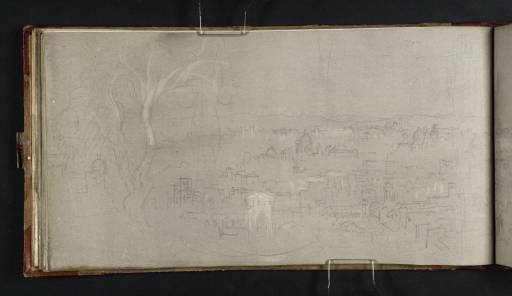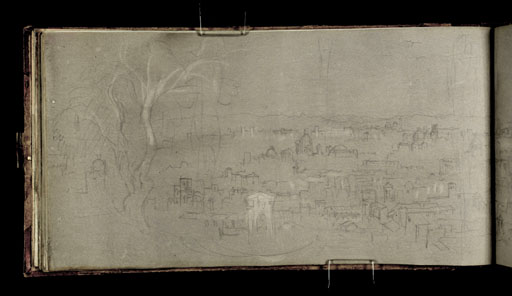Joseph Mallord William Turner View of Rome from Tasso's Oak on the Janiculum Hill 1819
Image 1 of 2
Joseph Mallord William Turner,
View of Rome from Tasso's Oak on the Janiculum Hill
1819
Joseph Mallord William Turner 1775–1851
Folio 29 Verso:
View of Rome from Tasso’s Oak on the Janiculum Hill 1819
D16446
Turner Bequest CXC 34 a
Turner Bequest CXC 34 a
Pencil and grey watercolour wash on white wove paper, 130 x 255 mm
Accepted by the nation as part of the Turner Bequest 1856
References
1909
A.J. Finberg, A Complete Inventory of the Drawings of the Turner Bequest, London 1909, vol.I, p.566, as ‘General view of Rome from Montorio’.
1984
Cecilia Powell, ‘Turner on Classic Ground: His Visits to Central and Southern Italy and Related Paintings and Drawings’, unpublished Ph.D thesis, Courtauld Institute of Art, University of London 1984, p.428, as ‘Rome from the north end of the Janiculum’.
As Cecilia Powell first identified, the subject of this sketch is a view of Rome seen from the Janiculum Hill.1 Like many eighteenth- and nineteenth-century visitors, part of Turner’s exploration of the city included the panoramic views seen from certain elevated vantage points. One of the most famous of these was the Janiculum Hill, a ridge of high ground to the west of the river Tiber which offered sweeping panoramas across the historical centre of the capital. The buildings visible within the foreground of this sketch include (from left to right): the dome of the Church of San Giovanni de Fiorentini; and to the right of the tree, the Palazzo Sacchetti. In the central middle ground is the dome of Sant’Agnese in Agnone with the flatter, broader dome of the Pantheon to the immediate right; San Andrea della Valle is further right; and finally, very faintly drawn near the fold of the page is San Carlo ai Catinari. Along the horizon can be seen the two towers of the Villa Medici and the long stretch of the Quirinal Palace, both highlighted in white. To the right of this are the two domes and obelisk of Santa Maria Maggiore and the darker square mass of the Torre Milize. Like many drawings within this sketchbook, the composition has been executed over a washed grey background and Turner has created areas of pale highlights by lifting or rubbing through to the white paper beneath. The view continues on the opposite sheet of the double-page spread, see folio 30 (D16447; Turner Bequest CXC 35).
The most celebrated vista on the Janiculum was that seen from the terrace or loggia of the Villa Lante, see folio 31 (D16449; Turner Bequest CXC 36). Turner’s viewpoint here, however, is further towards the northern tip of the hill. The tree which dominates the foreground on the right-hand side of the page is that known as ‘Tasso’s oak’, a fabled Roman landmark which stands on the northern tip of the hill. It is associated with the sixteenth-century poet Torquato Tasso (1544–1595), who according to legend spent the final year of his life waiting under the tree for official recognition for his works from the Pope. Tasso died in the nearby convent of Sant’Onofrio where his tomb now lies. His oak survived until the early twentieth century when it was struck by lightning.2 The remnants can still be seen today, held upright by concrete and metal scaffolding. Turner also made a sequence of sketches related to this location in the Albano, Nemi, Rome sketchbook (Tate D15369–D15370; Turner Bequest CLXXXII 39a–40), the St Peter’s sketchbook (see D16158–D16165; Turner Bequest CLXXXVIII 2–5) and the Rome: C. Studies sketchbook (see Tate D16378; Turner Bequest CLXXXIX 49). For other views from the Janiculum see the entry on folio 31.
Nicola Moorby
June 2009
How to cite
Nicola Moorby, ‘View of Rome from Tasso’s Oak on the Janiculum Hill 1819 by Joseph Mallord William Turner’, catalogue entry, June 2009, in David Blayney Brown (ed.), J.M.W. Turner: Sketchbooks, Drawings and Watercolours, Tate Research Publication, December 2012, https://www


